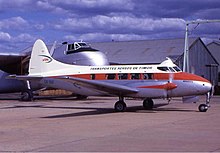de Havilland Dove
The design, which was a monoplane successor to the pre-war Dragon Rapide biplane, came about from the Brabazon Committee report which, amongst other aircraft types, called for a British-designed short-haul feeder for airlines.[7][2] In 1946, aviation magazine Flight praised the qualities of the newly developed Dove, noting its "modernity" as well as the aircraft's load-carrying capacity, safe engine-failure performance, and positive maintenance features.[3] Considerable attention was paid to aspects of maintainability, many of the components being designed to be interchangeable and easy to remove or replace, such as the rudder, elevator, and power units; other areas include the mounting of the engines upon four quick-release pickup points, the routing of cables and piping, and the detachable wings and tail cone.[5] The crew typically consisted of a pilot and radio operator, although rapidly removable dual flight controls could be installed for a second flying crewmember.[14] A TKS anti-icing system was available for the Dove, involving an alcohol-based jelly delivered via porous metal strips embedded on the leading edges of the wings and tail.[17][page needed] The Biafran Air Force operated a single Dove during the Nigerian Civil War; the aircraft was lost, to be subsequently found in 1970 on the premises of a school in Uli.[21] A few Doves and civilianised Devons remained in use in 2011 in the United Kingdom, Canada, Germany and elsewhere with small commercial firms and with private pilot owners.












Manufacturerde Havillandde Havilland Heronde Havilland Australia DHA-3 Drovershort-haulmonoplaneDragon RapidebiplaneBrabazon CommitteeRoyal Air ForceRoyal NavyRonald Bishopde Havilland Mosquitode Havilland CometSecond World WarDouglas DC-3constant-speed propellerstricycle undercarriageFlightrudderelevatoradhesivesrivetingfrictionaircraft lavatoryluggage compartmentaerial surveyair ambulanceclassroomexecutive transportradio operatorflight controlsperspexalcoholWellington AirportCentral African AirwaysHatfieldBroughtonChesterde Havilland Dragon RapideArgentine Air ForceLAN ChileRoyal New Zealand Air ForceBiafran Air ForceNigerian Civil WarPort HarcourtAlfredo Stroessnerde Havilland Canada DHC-6 Twin OtterSkywaysde Havilland Gipsy Queen 70-3piston enginesLong Beach airportFort WorthbulkheadsLong BeachCaliforniaGarrett AiResearch TPE331turbopropfuselageLycoming IO-720-A1AExecutive AirportFort Lauderdale, FloridaNational Test Pilot SchoolMojave AirportAustraliaAirlines of Western AustraliaMacRobertson Miller AirlinesRoyal Flying Doctor ServiceSouthern AirlinesBahrainGulf AviationBelgiumSABENAUnion of Burma AirwaysLAN-ChileDenmarkCimber AirGambiaWest African Airways CorporationGermanyHAL Aerospace MuseumBengaluruIndian National AirwaysMadrasIndonesiaIraq Petroleum CompanyNippon Helicopter and AeroplaneFar East AirlinesUgandaTanganyikaZanzibarEast African AirwaysNetherlandsMartinairNigeriaSouthern RhodesiaPortugalSATA – Sociedade Açoreana de Transportes AéreosTACV - Transportes Aéreos de Cabo VerdeDETA - Divisão e Exploração de Transportes AéreosTransportes Aéreos de TimorBankstown AirportDarwin Aviation MuseumBristol FreighterTAT - Transportes Aéreos de TimorSierra LeoneSouth AfricaComair (South Africa)South African AirwaysSudan AirwaysUnited KingdomBristow HelicoptersBritish MidlandBritish Westpoint AirlinesChannel AirwaysDan-AirHunting Aerosurveys LtdHunting-Clan Air TransportMorton Air ServicesSilver City AirwaysCAA Flying UnitUnited StatesAir WisconsinTAG AirlinesYugoslaviaJugoslovenski Aero-Transport